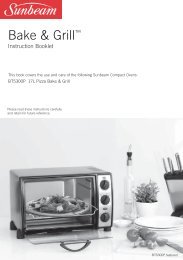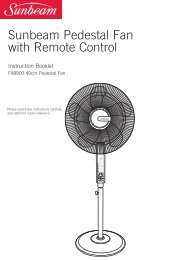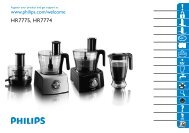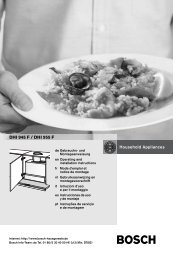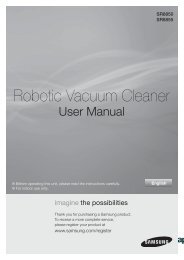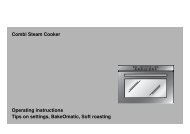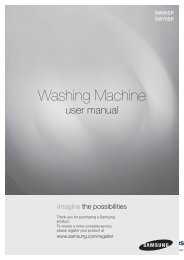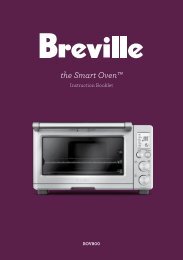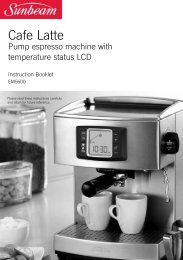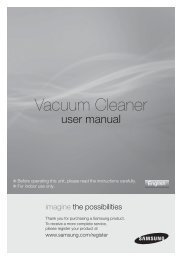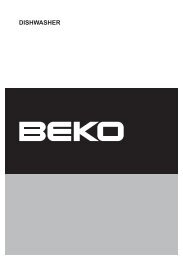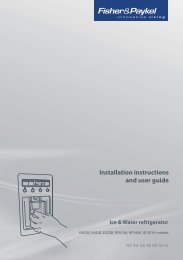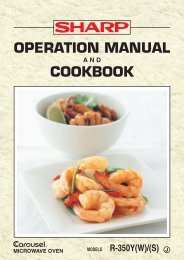GNE 134620 X - Beko
GNE 134620 X - Beko
GNE 134620 X - Beko
Create successful ePaper yourself
Turn your PDF publications into a flip-book with our unique Google optimized e-Paper software.
Refrigerator<br />
<strong>GNE</strong> <strong>134620</strong> X
Please read this manual first!<br />
Dear Customer,<br />
We hope that your product, which has been produced in state of the manufacturing<br />
facilities plants and checked under the most meticulous quality control procedures,<br />
will provide you an effective service.<br />
For this, we recommend you to carefully read the entire manual of your product<br />
before using it and keep it at hand for future references.<br />
This manual<br />
• Will help you use your appliance in a fast and safe way.<br />
• Read the manual before installing and operating your product.<br />
• Follow the instructions, especially those for safety.<br />
• Keep the manual in an easily accessible place as you may need it later.<br />
• Besides, read also the other documents provided with your product.<br />
Please note that this manual may be valid for other models as well.<br />
Symbols and their descriptions<br />
This instruction manual contains the following symbols:<br />
C Important information or useful usage tips.<br />
A Warning against dangerous conditions for life and property.<br />
B Warning against electric voltage.<br />
Recycling<br />
This product is supplied with the selective sorting symbol for waste electrical<br />
and electronic equipment (WEEE).<br />
This means that this product must be handled pursuant to European Directive<br />
2002/96/EC in order to be recycled or dismantled to minimise its impact on<br />
the environment. For further information, please contact your local or regional<br />
authorities.<br />
Electronic products not included in the selective sorting process are potentially<br />
dangerous for the environment and human health due to the presence of<br />
hazardous substances.<br />
www.beko.com<br />
This product was manufactured using the latest technology in environmentally friendly conditions.
CONTENTS<br />
1 Your Refrigerator 3<br />
2 Important Safety<br />
Warnings 4<br />
Intended use .....................................4<br />
For products with a water dispenser; .6<br />
Child safety ........................................6<br />
HCA Warning ....................................6<br />
Things to be done for energy saving ..6<br />
3 Installation 7<br />
Points to be considered when retransporting<br />
your refrigerator .............7<br />
Before operating your refrigerator ......7<br />
Electric connection ............................7<br />
Disposing of the packaging ...............8<br />
Disposing of your old refrigerator .......8<br />
Placing and Installation ......................8<br />
Floor balance adjustment ..................9<br />
Adjusting the gap between the upper<br />
door ..................................................9<br />
Installing Water Filter .......................11<br />
Connection of the Water Pipe to the<br />
Refrigerator .....................................11<br />
Connection of Water Hose to the<br />
Bottle .............................................12<br />
Connection of the Water Pipe to the<br />
Cold Water Mains Line ....................13<br />
Prior to first use of Water Dispenser .15<br />
4 Preparation 16<br />
2<br />
5 Using your refrigerator 17<br />
Indicator Panel .................................17<br />
Door Open Alarm: ..........................20<br />
Things to do to have the filter usage<br />
time calculated automatically ...........21<br />
Sliding Body Shelves .......................22<br />
Egg tray ...........................................22<br />
Crisper ............................................22<br />
0 °C compartment ..........................22<br />
Movable Middle Section .................23<br />
Multi Zone Storage Compartment ..23<br />
Blue light .........................................23<br />
Sliding Body Shelves With Rear<br />
Hangers ..........................................24<br />
Butter & Cheese Section .................24<br />
Using the water spring .....................24<br />
Spillage Tray ....................................24<br />
Minibar ............................................25<br />
6 Cleaning and care 26<br />
Protection of plastic surfaces ..........26<br />
7 Recommended solutions<br />
for the problems 27<br />
8 <strong>Beko</strong> Customer Care 30<br />
EN
1 Your Refrigerator<br />
1<br />
2<br />
3<br />
15<br />
4<br />
5<br />
6<br />
7<br />
8<br />
9<br />
1- Fridge compartment door<br />
shelves<br />
2- Fridge compartment glass<br />
shelves<br />
3- Diffuser cover<br />
4- Illumination lens<br />
5- Movable middle section<br />
6- 0 °C compartment<br />
7- Crisper<br />
8- Icematic<br />
9- Frozen food storage<br />
compartments<br />
C Figures that take place in this instruction manual are schematic and may not<br />
correspond exactly with your product. If the subject parts are not included in the<br />
product you have purchased, then it is valid for other models.<br />
17<br />
18 19<br />
3<br />
EN<br />
16<br />
10<br />
11<br />
12<br />
13<br />
14<br />
10- Minibar<br />
11- Bottle holder<br />
12- Bottle shelf<br />
13- Food storage compartment<br />
shelves<br />
14- Food storage compartments<br />
15- Water Filter<br />
16- Dairy compartment<br />
17- Fridge compartment<br />
18- Freezer compartment<br />
19- Multi Zone
2 Important Safety Warnings<br />
Please review the following information.<br />
Failure to observe this information may<br />
cause injuries or material damage.<br />
Otherwise, all warranty and reliability<br />
commitments will become invalid.<br />
Intended use<br />
This product is intended to be used<br />
– indoors and in closed areas such as<br />
homes;<br />
– in closed working environments such<br />
as stores and offices;<br />
– in closed accommodation areas such<br />
as farm houses, hotels,with retirement<br />
homes.<br />
• This product should not be used<br />
outdoors.<br />
General safety<br />
• When you want to dispose/scrap the<br />
product, we recommend you consult<br />
the authorized service agent in order<br />
to learn the required information and<br />
authorized bodies.<br />
• Consult your authorized service agent<br />
for all your questions and problems<br />
related to the refrigerator. Do not<br />
intervene or let someone intervene to<br />
the refrigerator without notifying the<br />
authorised services.<br />
• For products with a freezer<br />
compartment; Caution, eating of ice<br />
cream or ice cubes immediately after<br />
removing from freezer may cause<br />
discomfort due to the extreme cold.<br />
• For products with a freezer<br />
compartment; Do not put bottled and<br />
canned liquid beverages in the freezer<br />
compartment. Otherwise, these may<br />
burst.<br />
• Do not touch frozen food by hand; they<br />
may stick to your hand.<br />
• Unplug your refrigerator before cleaning<br />
or defrosting.<br />
4<br />
• Pressure or spray cleaning materials<br />
should never be used in cleaning<br />
and defrosting processes of your<br />
refrigerator. In such cases, the solution<br />
may get in contact with the electrical<br />
parts and cause short circuit or electric<br />
shock.<br />
• Never use the parts on your refrigerator<br />
such as the door as a means of<br />
support or step.<br />
• Do not use electrical devices inside the<br />
refrigerator.<br />
• Do not drill or cut the refrigerator as you<br />
may release the refrigerant gas. This<br />
may cause irritation to the skin or injury<br />
to the eye.<br />
.• Do not cover or block the ventilation<br />
holes on your refrigerator with any<br />
material.<br />
• Electrical devices must be repaired<br />
by only authorised persons. Repairs<br />
performed by incompetent persons<br />
create a risk for the user.<br />
• In case of any failure or during a<br />
maintenance or repair work, disconnect<br />
your refrigerator’s mains supply by<br />
either turning off the relevant fuse or<br />
unplugging your appliance.<br />
• Do not pull by the cable when pulling<br />
off the plug.<br />
• Place the beverage with higher proofs<br />
tightly closed and vertically.<br />
• Never store spray cans containing<br />
flammable and explosive substances in<br />
the refrigerator.<br />
• Do not use mechanical devices<br />
or other means to accelerate the<br />
defrosting process, other than those<br />
recommended by the manufacturer.<br />
• Do not operate a damaged refrigerator.<br />
Consult with the service agent if you<br />
have any concerns.<br />
EN
• Electrical safety of your refrigerator shall<br />
be guaranteed only if the earth system<br />
in your house complies with standards.<br />
• Exposing the product to rain, snow, sun<br />
and wind is dangerous with respect to<br />
electrical safety.<br />
• Contact your authorised service agent<br />
in the event of damage caused to your<br />
power cable.<br />
• Please contact an authorised electrician<br />
in the event of power cord damage.<br />
• Never plug the refrigerator into the wall<br />
outlet during installation. Otherwise, risk<br />
of death or serious injury may arise.<br />
• This refrigerator is intended for only<br />
storing food items. It must not be used<br />
for any other purpose.<br />
• Label of technical specifications is<br />
located on the left wall inside the<br />
refrigerator.<br />
• Never connect your refrigerator to<br />
electricity-saving systems; they may<br />
damage the refrigerator.<br />
• If there is a blue light on the refrigerator,<br />
do not look at the blue light with optical<br />
tools.<br />
• For manually controlled refrigerators,<br />
wait for at least 5 minutes to start the<br />
refrigerator after power failure.<br />
• This operation manual should be<br />
handed in to the new owner of the<br />
product when it is given to others.<br />
• Avoid causing damage on power cable<br />
when transporting the refrigerator.<br />
Bending cable may cause fire. Never<br />
place heavy objects on power cable.<br />
Do not touch the plug with wet hands<br />
when plugging the product.<br />
• Do not plug the refrigerator if the wall<br />
outlet is loose.<br />
• Water should not be sprayed directly on<br />
inner or outer parts of the product for<br />
safety purposes.<br />
5<br />
• Do not spray substances containing<br />
inflammable gases such as propane<br />
gas near the refrigerator to avoid fire<br />
and explosion risk.<br />
• Never place containers filled with water<br />
on top of the refrigerator, otherwise this<br />
may cause electric shock or fire.<br />
• Do not overload your refrigerator<br />
with excessive amounts of food. If<br />
overloaded, the food items may fall<br />
down hurt you and damage refrigerator<br />
when you open the door. Never place<br />
objects on top of the refrigerator;<br />
otherwise, these objects may fall<br />
down when you open or close the<br />
refrigerator’s door.<br />
• As they require a precise temperature,<br />
vaccines, heat-sensitive medicine<br />
scientific materials etc. should not be<br />
kept in the refrigerator.<br />
• If not to be used for a long time,<br />
refrigerator should be unplugged.<br />
• The plug’s tip should be regularly<br />
cleaned; otherwise, it may cause fire.<br />
• Refrigerator may move if adjustable feet<br />
are not properly secured on the floor.<br />
Properly securing adjustable feet on<br />
the floor can prevent the refrigerator to<br />
move.<br />
• When carrying the refrigerator, do not<br />
hold it from door handle. Otherwise, it<br />
may snap or break.<br />
• When you have to place your product<br />
next to another refrigerator or freezer,<br />
the distance between devices should<br />
be at least 8cm. Otherwise, adjacent<br />
EN side walls may be humidified.
For products with a water<br />
dispenser;<br />
For a mains connected system the<br />
minimum pressure should be 100 kpa<br />
and the maximum pressure should not<br />
exceed 800 kpa.<br />
• Use filtered water only.<br />
Child safety<br />
• If the door has a lock, the key should<br />
be kept away from reach of children.<br />
• Children must be supervised to prevent<br />
them from tampering with the product.<br />
HCA Warning<br />
If your product's cooling system<br />
contains R600a:<br />
This gas is flammable. Therefore, pay<br />
attention to not damaging the cooling<br />
system and piping during usage and<br />
transportation. In the event of damage,<br />
keep your product away from potential<br />
fire sources that can cause the product<br />
catch a fire and ventilate the room in<br />
which the unit is placed.<br />
6<br />
Things to be done for energy<br />
saving<br />
• Do not leave the doors of your<br />
refrigerator open for a long time.<br />
• Do not put hot food or drinks in your<br />
refrigerator.<br />
• Do not overload your refrigerator in<br />
a way that will prevent or restrict air<br />
circulation inside the cabinet.<br />
• Do not install your refrigerator under<br />
direct sunlight or near heat emitting<br />
appliances such as ovens, dishwashers<br />
or radiators.<br />
• Pay attention to keep your food in<br />
closed containers.<br />
• For products with a freezer<br />
compartment; You can store maximum<br />
amount of food items in the freezer<br />
when you remove the shelf or drawer<br />
of the freezer. Energy consumption<br />
value stated for your refrigerator has<br />
been determined by removing freezer<br />
shelf or drawer and under maximum<br />
load. There is no harm to use a shelf or<br />
drawer according to the shapes and<br />
size of food to be frozen.<br />
• Thawing frozen food in fridge<br />
compartment will both provide energy<br />
saving and preserve the food quality.<br />
EN
3 Installation<br />
C Please remember that the manufacturer<br />
shall not be held liable if the information<br />
given in the instruction manual is not<br />
observed.<br />
Points to be considered<br />
when re-transporting your<br />
refrigerator<br />
1. Your refrigerator must be emptied and<br />
cleaned prior to any transportation.<br />
2. Shelves, accessories, crisper and etc.<br />
in your refrigerator must be fastened<br />
securely by adhesive tape against any<br />
jolt before repackaging.<br />
3. Packaging must be tied with thick<br />
tapes and strong ropes and the rules of<br />
transportation printed on the package<br />
must be followed.<br />
C Always remember...<br />
Every recycled material is an<br />
indispensable source for nature and for<br />
our national resources.<br />
If you wish to contribute to recycling the<br />
packaging materials, you can get further<br />
information from the environmental<br />
bodies or local authorities.<br />
Before operating your<br />
refrigerator<br />
Before starting to use your refrigerator<br />
check the following:<br />
1. Is the interior of the refrigerator dry and<br />
can the air circulate freely in the rear of<br />
it?<br />
2. Insert the 2 plastic wedges onto the<br />
rear ventilation cover as illustrated in<br />
the following figure. To do this, remove<br />
the screws on the product and use the<br />
screws given in the same pouch.<br />
Plastic wedges will provide the required<br />
distance between your refrigerator<br />
and the wall in order to allow the air<br />
circulation.<br />
7<br />
3. Clean the interior of the refrigerator as<br />
recommended in the “Maintenance and<br />
cleaning” section.<br />
4. Plug the refrigerator into the wall outlet.<br />
When the door is open the respective<br />
interior light will come on.<br />
5. You will hear a noise as the compressor<br />
starts up. The liquid and gases sealed<br />
within the refrigeration system may<br />
also give rise to noise, even if the<br />
compressor is not running and this is<br />
quite normal.<br />
6. Front edges of the refrigerator may<br />
feel warm. This is normal. These areas<br />
are designed to be warm to avoid<br />
condensation.<br />
Electric connection<br />
Connect your refrigerator to a grounded<br />
socket which is being protected by a<br />
fuse with the appropriate capacity.<br />
Important:<br />
B The connection must be compliant with<br />
national regulations.<br />
B The power cable plug must be easily<br />
accessible after installation.<br />
B Voltage and allowable fuse protection<br />
are specified in the “Technical<br />
Specifications” section.<br />
EN
BThe specified voltage must be equal to<br />
your mains voltage.<br />
B Extension cables and multiway plugs<br />
must not be used for connection.<br />
B A damaged power cable must be<br />
replaced by a qualified electrician.<br />
B The appliance must not be operated<br />
before it is repaired! There is danger of<br />
electric shock!<br />
Disposing of the packaging<br />
A The packing materials may be<br />
dangerous for children. Keep the<br />
packing materials out of the reach<br />
of children or dispose them of by<br />
classifying them in accordance<br />
with the waste instructions. Do not<br />
dispose them of along with the normal<br />
household waste.<br />
The packing of your refrigerator is<br />
produced from recyclable materials.<br />
Disposing of your old<br />
refrigerator<br />
Dispose of your old machine without<br />
causing any harm to the environment.<br />
A You may consult your authorized dealer<br />
or waste collection center of your<br />
municipality about the disposal of your<br />
refrigerator.<br />
A Before disposing of your refrigerator,<br />
cut off the electric plug and, if there<br />
are any locks on the door, make them<br />
inoperable in order to protect children<br />
against any danger.<br />
Placing and Installation<br />
B Caution: Never plug the refrigerator<br />
into the wall outlet during installation.<br />
Otherwise, risk of death or serious injury<br />
may arise.<br />
8<br />
A If the entrance door of the room<br />
where the refrigerator will be installed is<br />
not wide enough for the refrigerator to<br />
pass through, than call the authorised<br />
service to have them remove the doors<br />
of your refrigerator and pass it sideways<br />
through the door.<br />
1. Install your refrigerator to a place that<br />
allows ease of use.<br />
2. Keep your refrigerator away from<br />
heat sources, humid places and direct<br />
sunlight.<br />
3. There must be appropriate air<br />
ventilation around your refrigerator in<br />
order to achieve an efficient operation.<br />
If the refrigerator is to be placed in a<br />
recess in the wall, there must be at least<br />
5 cm distance with the ceiling and at<br />
least 5 cm with the wall.<br />
If the floor is covered with a carpet, your<br />
product must be elevated 2.5 cm from<br />
the floor.<br />
4. Place your refrigerator on an even<br />
floor surface to prevent jolts.<br />
5. Do not keep your refrigerator in<br />
ambient temperatures under 10°C.<br />
EN
Floor balance adjustment<br />
AIf your refrigerator is unbalanced;<br />
B First unplug the product. The product<br />
must be unplugged when making the<br />
balance adjustment. There is the risk of<br />
electric shock.<br />
4<br />
1 2 3<br />
1- Ventilation cover is removed by<br />
unscrewing its screws as illustrated in<br />
the figure before the procedure. You<br />
can balance your refrigerator by turning<br />
the front feet of it as illustrated in the<br />
figure. The corner where the leg exists is<br />
lowered when you turn in the direction of<br />
black arrow and raised when you turn in<br />
the opposite direction. Taking help from<br />
someone to slightly lift the refrigerator will<br />
facilitate this process.<br />
2. After the balance issue is remedied,<br />
install back the ventilation cover and<br />
fasten the screws.<br />
3. Remove the screws fastening the<br />
lower ventilation cover using a Philips<br />
screwdriver.<br />
9<br />
Adjusting the gap between<br />
the upper door<br />
C You can adjust the gap between the<br />
fridge compartment doors as illustrated<br />
in the figures.<br />
Door shelves should be empty when<br />
adjusting the door height.<br />
C Using a screwdriver, remove the<br />
screw of upper hinge cover of the door<br />
you want to adjust.<br />
EN
C Adjust the door appropriately as you<br />
desire by loosing the screws.<br />
C Fix the door you have adjusted by<br />
tightening the screws without changing<br />
the position of the door.<br />
C Replace the hinge cover and fix with<br />
the screw.<br />
10<br />
EN
Installing Water Filter<br />
(in some models)<br />
Two different water sources may<br />
be connected to the refrigerator for<br />
water supply: the mains cold water<br />
supply and water in a bottle.<br />
Installation Requirements<br />
A pump should be used for bottle water<br />
usage.<br />
Check that the parts stated below are<br />
supplied with your appliance.<br />
1. Union for connection of the water<br />
pipe to the rear of the appliance. (If it<br />
does not fit, provide it from the nearest<br />
authorized service.)<br />
2. 2 pieces of pipe clips (In case required<br />
to secure the water pipe)<br />
Note: Since the following parts are<br />
not required in use with a bottle, they<br />
may not be found in the product you<br />
purchased.<br />
3. 5-meter long water pipe (1/4 inch in<br />
diameter)<br />
4. Cold mains water valve with mesh filter<br />
(Tap Adapter)<br />
5. Water Filter or externally connectable<br />
filter to be fitted to the bracket inside<br />
the fridge compartment.<br />
Place where the external filter is going to<br />
be fitted should be determined first.<br />
3<br />
1<br />
2<br />
4<br />
5<br />
11<br />
(Applies to the filter being used outside<br />
the refrigerator.) Then, determine the<br />
distance between the filter and the<br />
refrigerator and required hose lengths<br />
from the filter to the refrigerator water<br />
inlet.<br />
Water filter must be hold upright as shown<br />
in the figure. It is important to properly<br />
attach the filter to water inlet and water<br />
outlet points.<br />
After attaching the filter, do not use first 3-4<br />
glasses of water.<br />
Connection of the Water<br />
Pipe to the Refrigerator<br />
1. After installing the union onto the<br />
water pipe, insert the water pipe to<br />
the refrigerator inlet valve by pressing<br />
downwards firmly.<br />
2. Fix union as seen in the opposite<br />
figure, by squeezing by hand on the<br />
refrigerator inlet valve.<br />
(a- Water Pipe, b-Union, c-Valve)<br />
C Note 1: You should not need to<br />
tighten the union with a tool to achieve<br />
water tight assembly. In case of a leak<br />
use a spanner or a pair of pliers to<br />
tighten the union.<br />
EN<br />
a<br />
2<br />
a<br />
c<br />
b<br />
1
Connection of Water Hose to<br />
the Bottle<br />
(in some models)<br />
To connect water to the refrigerator from<br />
a bottle, a pump is needed. Follow the<br />
instructions below after connecting one<br />
end of the water pipe coming out of the<br />
pump to the refrigerator as described on<br />
the previous page.<br />
1. Finish the connection by pushing the<br />
other end of the water pipe into the<br />
water pipe inlet of the pump as shown<br />
in the figure.<br />
1a<br />
1b<br />
12<br />
2. Put and fix the pump hose into the<br />
bottle as shown in the figure.<br />
3. After completing the connection, plug in<br />
and run the pump.<br />
To provide an efficient operation of the<br />
pump, wait for 2-3 minutes after<br />
starting the pump.<br />
C You may refer to the user manual<br />
of the pump while making the water<br />
connection.<br />
C There is no need to use water filter in<br />
case a bottle is used.<br />
C Pump must be used when bottle will be<br />
used.<br />
2<br />
EN
Connection of the Water<br />
Pipe to the Cold Water Mains<br />
Line<br />
(in some models)<br />
If you want to use your refrigerator by<br />
connecting it to the cold water mains<br />
line,<br />
you will have to connect a standard 1/2"<br />
valve connection fitting to the cold water<br />
supply in your house. In case this valve is<br />
not present or in case you are not sure,<br />
consult a qualified plumber.<br />
1. Separate the union from the tap<br />
adaptor. (Figure A)<br />
2. Install the tap adaptor to 1/2” valve<br />
fitting as shown in the figure. (Figure B)<br />
3. After inserting the water pipe to the<br />
union, install it to the tap adaptor and<br />
insert to the tap as shown in the figure.<br />
(Figure C)<br />
4. Tighten the union manually. In case of a<br />
leak use a spanner or a pair of pliers to<br />
tighten the union.<br />
A Caution: Secure the water pipe<br />
to suitable points by means of the<br />
pipe clips supplied to avoid any<br />
damage or displacement or accidental<br />
disconnection.<br />
A Caution: After turning on the water<br />
valve, make sure that there is no leakage<br />
at both connection points of the water<br />
pipe. In case of a leak, turn off the valve<br />
immediately and tighten all joints again<br />
using a spanner or a pair of pliers.<br />
A Caution: Make sure that standard<br />
1/2" valve fitting fed by cold mains water<br />
supply is available and is turned off fully.<br />
To fit the water filter follow the<br />
instructions below referring to figures<br />
supplied:<br />
1. Press ice cancel button on the display.<br />
13<br />
EN
2. Remove the filter cover in the fridge<br />
compartment by pulling it forward.<br />
3. Take out the water filter by-pass cover<br />
14<br />
by rotating it downwards.<br />
A Caution: Make sure that the “Ice off”<br />
mode is active before taking out the bypass<br />
cover.<br />
Note: It is normal that a few drops of<br />
water drip after the cover has been taken<br />
out.<br />
4. Remove the lid on top of the water filter<br />
to place it as shown in the figure and<br />
turn upwards to lock it.<br />
5. Press ice cancel button on the display<br />
again to exit from this mode.<br />
Water filter should be replaced every 6<br />
months.<br />
If you want to have the filter change time<br />
calculated automatically and receive a<br />
warning at the end of usage time, please<br />
read "Calculating the Filter Usage Time<br />
Automatically" section.<br />
The water filter must be removed as<br />
EN
shown in the figure when it is going to<br />
be replaced or when it will no longer<br />
be used and by-pass cover must be<br />
attached. It must be made sure that Ice<br />
Off mode is active before taking it out.<br />
A Caution: Water filter cleans some<br />
foreign particles in the water. It does not<br />
purify water from microorganisms.<br />
A Caution: Ice Off button must always<br />
be pressed during replacement of the<br />
water filter or installing the by-pass<br />
cover.<br />
Prior to first use of Water<br />
15<br />
Dispenser<br />
C Water mains pressure must not be<br />
below 100 kpa.<br />
C Water mains pressure must not 800<br />
kpa.<br />
C Pumps must be used in case the<br />
supply water pressure drops below 1 bar<br />
or if a bottle is going to be used.<br />
C Water system of the refrigerator must<br />
be connected to the cold water line. It<br />
must not be connected to hot water line.<br />
C No water may be obtained in the<br />
initial operation of the refrigerator. This<br />
is caused by the air in the system. To<br />
discharge air from the system, press<br />
Dispenser latch for periods of 1 minute<br />
until water comes from the Dispenser.<br />
Water flow may be irregular in the<br />
beginning. Irregular water flow will be<br />
normalized after the air in the system is<br />
discharged.<br />
C At the initial startup of the refrigerator<br />
approx.12 hours must pass before cold<br />
water can be obtained.<br />
C Water mains pressure must be<br />
between 100 - 800 kpa for the operation<br />
of Ice/Water Dispenser smoothly. For<br />
this, check that 1 glass of water (100 cc)<br />
can be filled in 10 seconds.<br />
C The first 10 glasses of water should<br />
not be consumed.<br />
C Approximately the first 30 cubes<br />
of ice to be obtained from the Ice<br />
Dispenser must not be used.<br />
C Always use the water filter when a<br />
bottle is not being used.<br />
EN
4 Preparation<br />
C Your refrigerator should be installed at<br />
least 30 cm away from heat sources<br />
such as hobs, ovens, central heater<br />
and stoves and at least 5 cm away<br />
from electrical ovens and should not be<br />
located under direct sunlight.<br />
C The ambient temperature of the room<br />
where you install your refrigerator<br />
should at least be 10°C. Operating your<br />
refrigerator under cooler conditions<br />
than this is not recommended with<br />
regard to its efficiency.<br />
C Please make sure that the interior of<br />
your refrigerator is cleaned thoroughly.<br />
C If two refrigerators are to be installed<br />
side by side, there should be at least 2<br />
cm distance between them.<br />
C When you operate your refrigerator<br />
for the first time, please observe the<br />
following instructions during the initial<br />
six hours.<br />
- The door should not be opened<br />
frequently.<br />
- It must be operated empty without<br />
any food in it.<br />
- Do not unplug your refrigerator. If<br />
a power failure occurs out of your<br />
control, please see the warnings in<br />
the “Recommended solutions for the<br />
problems” section.<br />
C Original packaging and foam<br />
materials should be kept for future<br />
transportations or moving.<br />
16<br />
EN
2<br />
3<br />
5 Using your refrigerator<br />
Indicator Panel<br />
This touch-control indicator panel allows you to set the temperature without opening<br />
the door of your refrigerator. Just touch the relevant button with your finger to set the<br />
temperature.<br />
17<br />
1. Eco-Extra / Vacation Button<br />
2. Fast Freeze Button<br />
3. Freezer Compartment Temperature<br />
Setting Button<br />
4. Fridge Compartment Temperature<br />
Setting Button<br />
5. Quick Cool Button<br />
6. Multi Zone Compartment<br />
Temperature Setting Button<br />
7. Vacation Function Indicator<br />
8. Eco-Extra Function Indicator<br />
9. Fast Freeze Function Indicator<br />
10. Freezer Compartment Temperature<br />
Indicator<br />
1 18 7 11 12 15 20 4 19<br />
10 9 8 14 13<br />
17<br />
EN<br />
5<br />
16<br />
11. Fridge Compartment Temperature<br />
Indicator<br />
12. Quick Cool Function Indicator<br />
13. Multi Zone Compartment Temperature<br />
Indicator<br />
14. Economy Mode Indicator<br />
15. Error Status Indicator<br />
16. Key Lock Indicator<br />
17. Ice Cancel Button<br />
18. Ice Off indicator<br />
19. Cancel Filter Change Warning Button<br />
20. Filter Change Warning Indicator<br />
6
1. Eco Extra/Vacation Button<br />
Press this button briefly to activate the<br />
Eco Extra function. Press and hold this<br />
button for 3 sec. to activate the Vacation<br />
function. Press this button again to<br />
deactivate the selected function.<br />
2. Fast Freeze Button<br />
Press this button briefly to activate the<br />
Fast Freeze function. Press this button<br />
again to deactivate the selected function.<br />
3. Freezer Compartment<br />
Temperature Setting Button<br />
Press this button to set the temperature<br />
of the freezer compartment to -15 / -18 /<br />
-21 / -24 -15... respectively. Press this<br />
button to set the desired temperature for<br />
the Freezer Compartment.<br />
4. Fridge Compartment Temperature<br />
Setting Button<br />
Press this button to set the temperature<br />
of the fridge compartment to 8, 6, 4, 2,<br />
8... respectively. Press this button to set<br />
the desired temperature for the Fridge<br />
Compartment.<br />
5. Quick Cool Button<br />
Press this button briefly to activate the<br />
Quick Cool function. Press this button<br />
again to deactivate the selected function.<br />
6. Multi Zone Compartment<br />
Temperature Setting Button<br />
You can set the Multi Zone<br />
Compartment either as a Freezer or a<br />
Cooler. Press and hold this button for a<br />
long time (3 sec) to set the Multi Zone<br />
Compartment as a Freezer or a Cooler.<br />
This compartment is set as a Freezer<br />
Compartment at factory.<br />
18<br />
If the Multi Zone Compartment is set as<br />
a Freezer, then the temperature of the<br />
Multi Zone Compartment will change<br />
as -15, -18, -21, -24, -15... respectively<br />
each time you press this button. If the<br />
Multi Zone Compartment is set as a<br />
Fridge, then the temperature of the Multi<br />
Zone Compartment will change as 10, 8,<br />
6, 4, 2, 0, -6, ... respectively each time<br />
you press this button.<br />
7. Vacation Function Indicator<br />
Indicates that the vacation function<br />
is active. If this function is active,<br />
"- -" appears on the indicator of the<br />
fridge compartment and no cooling is<br />
performed in the fridge compartment.<br />
Other compartments will be cooled in<br />
accordance with the temperature set for<br />
them.<br />
Press the relevant button again to<br />
deactivate this function.<br />
8. Eco Extra Function Indicator<br />
It indicates that the Eco-Extra function<br />
is active. If this function is active, your<br />
refrigerator will automatically detect<br />
the least usage periods and energyefficient<br />
cooling will be performed during<br />
those times. Economy indicator will be<br />
active while energy-efficient cooling is<br />
performed.<br />
Press the relevant button again to<br />
deactivate this function.<br />
EN
9. Quick Freeze Function Indicator<br />
It indicates that the Fast Freeze function<br />
is active. Use this function when<br />
you place fresh food into the freezer<br />
compartment or when you need ice.<br />
When this function is active, your<br />
refrigerator will run for a certain period of<br />
time.<br />
Press the relevant button again to<br />
deactivate this function.<br />
10. Freezer Compartment<br />
Temperature Indicator<br />
It indicates the temperature set for<br />
Freezer Compartment.<br />
11. Fridge Compartment<br />
Temperature Indicator<br />
Indicates the temperature set for Fridge<br />
Compartment.<br />
12. Quick Cool Function Indicator<br />
Indicates that the Quick Cool function is<br />
active. Use this function when you place<br />
fresh food into the fridge compartment<br />
or when you need to cool your food<br />
quickly. When this function is active, your<br />
refrigerator will run for 2 hours without<br />
stopping.<br />
Press the relevant button again to<br />
deactivate this function.<br />
13. Multi Zone Compartment<br />
Temperature Indicator<br />
It indicates the temperature set for Multi<br />
Zone compartment.<br />
19<br />
14. Economy Mode Indicator<br />
Indicates that the refrigerator is running<br />
in energy-efficient mode. Freezer<br />
Compartment temperature<br />
This indicator will be active if the function<br />
is set to -15 or the energy efficient<br />
cooling is being performed due to Eco-<br />
Extra function.<br />
15. Error Status Indicator<br />
If your refrigerator does not cool<br />
adequately or if there is a sensor failure,<br />
this indicator will be activated. When this<br />
indicator is active, Freezer Compartment<br />
Temperature indicator will display "E"<br />
and Fridge Compartment Temperature<br />
Indicator will display numbers such<br />
as "1,2,3…". These numbers on the<br />
indicator provides information about the<br />
error to the service personnel.<br />
16. Key Lock Indicator<br />
Use this function if you do not want your<br />
refrigerator temperature setting changed.<br />
Press Quick Cool Button and Flexi Zone<br />
Compartment Temperature Setting<br />
Button simultaneously for a long time (3<br />
sec) to activate this feature.<br />
Press the relevant buttons again to<br />
deactivate this function.<br />
17. Ice Cancel Button<br />
To stop ice formation, ice cancel button<br />
is pressed for 3 seconds. When ice<br />
cancel is selected, no water will be sent<br />
to the ice box. Despite this, some ice<br />
may be leftover in the ice box which<br />
may be taken from there. To restart ice<br />
formation, ice cancel button has to be<br />
pressed for 3 seconds.<br />
EN
18. Ice Cancel Indicator<br />
If you do not want to get ice from<br />
the refrigerator, you need to use this<br />
function. You may use this function by<br />
pressing the ice cancel button for 3<br />
seconds.<br />
19. Cancel Filter Change Warning<br />
Button<br />
Filter of your refrigerator must be<br />
replaced every 6 months. If you apply<br />
instructions on page 22, your refrigerator<br />
calculates this time automatically and<br />
the filter change waning indicator<br />
illuminates when the filter usage time<br />
has elapsed. Press Cancel filter change<br />
warning button for 3 seconds to allow<br />
the refrigerator to calculate the new filter<br />
time automatically after changing the<br />
filter.<br />
20. Cancel Filter Change Warning<br />
Indicator<br />
When the filter usage time has elapsed,<br />
filter change warning indicator starts to<br />
illuminate.<br />
Door Open Alarm:<br />
In case of leaving any of the<br />
Fridge Compartment or Flexi Zone<br />
Compartment doors open minimum for<br />
1 minute, audible Door Open Alarm will<br />
be activated and heard. Just press any<br />
button on the indicator or close the open<br />
door to silence the alarm.<br />
20<br />
EN
Things to do to have the filter usage time calculated<br />
automatically<br />
(For products connected to the mains water line and equipped with filter)<br />
1- After plugging the refrigerator in, press A and B buttons together to activate<br />
the key lock.<br />
2- Then press Eco-Extra (1), Fridge Compartment Temperature Setting (4), Quick<br />
Cool (5) and Freezer Compartment Temperature Setting (3) buttons respectively.<br />
1 4<br />
3<br />
If button configuration is pressed in the correct order, key lock symbol will go off,<br />
buzzer will be activated shortly, and Filter change warning indicator illuminates.<br />
Press cancel filter change warning button (Item 19 in display descriptions) after<br />
changing the filter to have the filter usage time calculated automatically.<br />
NOTE:<br />
1. If the filter usage time is being calculated automatically, filter change warning<br />
indicator will illuminate continuously in a few seconds after the product is<br />
plugged in.<br />
2. Automatic filter usage time calculation is not active ex factory. It must be<br />
activated in products equipped with a filter.<br />
3. Repeat the same procedure in products whose automatic filter usage time<br />
calculation is activated in order to deactivate the filter usage time calculation.<br />
21<br />
EN<br />
A<br />
B<br />
5
Egg tray<br />
You can install the egg holder to the<br />
desired door or body shelf.<br />
Never store the egg holder in the freezer<br />
compartment<br />
Sliding Body Shelves<br />
Sliding body shelves can be pulled<br />
by slightly lifting up from the front and<br />
moved back and forth. They come to a<br />
stop point when pulled towards front to<br />
allow you reach the foods placed at the<br />
back of the shelf; when it is pulled after<br />
slightly lifted upwards at the second stop<br />
point, the body shelf will be released.<br />
The shelf should be hold tightly from the<br />
bottom as well in order to prevent it from<br />
tipping over. The body shelf is placed on<br />
the rails at the sides of the refrigerator<br />
body by bringing it to one lower or one<br />
upper level.<br />
The body shelf should be pushed<br />
backwards to seat it completely.<br />
2<br />
1<br />
3<br />
4<br />
22<br />
Crisper<br />
Crisper of your refrigerator is designed<br />
specially to keep your vegetables<br />
freshly without loosing their humidity.<br />
For this purpose, cool air circulation<br />
occurs around the crisper in general.<br />
Remove the door shelves that align<br />
with the crisper before removing the<br />
crispers. You can remove the crispers<br />
as illustrated in the figure.<br />
0 °C compartment<br />
0 °C compartments enable the foods<br />
to be frozen become ready for freezing.<br />
You can also use these compartments to<br />
store your food at a temperature a few<br />
degrees below the fridge compartment.<br />
You can increase the inner volume of<br />
your refrigerator by removing any of<br />
the 0 °C compartments. To do this,<br />
pull the compartment towards yourself;<br />
the compartment will lean against the<br />
stopper and stop. This compartment will<br />
be released when you lift it about 1 cm<br />
and pull it towards yourself.<br />
EN
Movable Middle Section<br />
Movable middle section is intended<br />
to prevent the cold air inside your<br />
refrigerator from escaping outside.<br />
1- Sealing is provided when the gaskets<br />
on the door presses on the surface of<br />
the movable middle section while the<br />
fridge compartment doors are closed.<br />
2- Another reason that your refrigerator<br />
is equipped with a movable middle<br />
section is that it increases the net volume<br />
of the fridge compartment. Standard<br />
middle sections occupy some nonusable<br />
volume in the refrigerator.<br />
3- Movable middle section is closed<br />
when the left door of the fridge<br />
compartment is closed.<br />
4- It must not be opened manually. It<br />
moves under the guidance of the plastic<br />
part on the body while the door is<br />
closed. Blue light<br />
Multi Zone Storage<br />
Compartment<br />
The Multi Zone Storage Compartment<br />
of your refrigerator may be used in<br />
any desired mode by adjusting it to<br />
fridge (2/4/6/8 °C) or freezer (-15/-<br />
18/-21/-24) temperatures. You can<br />
keep the compartment in the desired<br />
temperature with the Multi Zone Storage<br />
Compartment Temperature Setting<br />
Button. The temperature of the Multi<br />
Zone Storage Compartment may be<br />
set to 0 and 10 degrees in addition to<br />
the fridge compartment temperatures<br />
and to -6 degrees in addition to the<br />
freezer compartment temperatures. 0<br />
degree is used to store the deli products<br />
longer, and -6 degrees is used to keep<br />
the meats up to 2 weeks in an easily<br />
cuttable condition.<br />
23<br />
C The feature of switching to a<br />
Fridge or Freezer compartment is<br />
provided by a cooling element located<br />
in the closed section (Compressor<br />
Compartment) behind the refrigerator.<br />
During operation of this element,<br />
sounds similar to the sound of<br />
seconds heard from an analog clock<br />
may be heard. This is normal and is<br />
not fault cause.<br />
Foodstuff stored in the crispers that are<br />
enlightened with a blue light continue<br />
their photosynthesis by means of the<br />
wavelength effect of blue light and thus,<br />
preserve their freshness and increase<br />
their vitamin content.<br />
EN
Sliding Body Shelves With<br />
Rear Hangers<br />
Sliding body shelves with rear hangers<br />
can be moved back and forth. Height<br />
of these shelves can be adjusted by<br />
removing and then installing them to<br />
upper or lower positions. Raise the shelf<br />
up slightly and pull towards yourself to<br />
remove it.<br />
Butter & Cheese Section<br />
You can store food such as butter,<br />
cheese, and margarine in this section<br />
which has a lid.<br />
24<br />
Using the water spring<br />
Warnings<br />
It is normal for the first few glasses of water<br />
taken from the dispenser to be warm.<br />
In cases where the water dispenser has not<br />
been used frequently, sufficient amount of<br />
water must be drained from the dispenser<br />
to get fresh water.<br />
Spillage Tray<br />
Water drops that drip during use,<br />
accumulates in the spillage tray. You can<br />
remove spillage tray by pulling it to yourself<br />
or pressing on its edge (depending on the<br />
model). You can remove the water with a<br />
sponge or a soft cloth.<br />
EN
Minibar<br />
Minibar door provides you extra comfort<br />
when using your refrigerator. The door<br />
shelf in the refrigerator can be accessed<br />
without opening the refrigerator door;<br />
thanks to this feature, you can easily pick<br />
from the refrigerator the foods and drinks<br />
which you frequently consume. Since<br />
you do not have to open the refrigerator<br />
door frequently, you will have decreased<br />
the power consumption of refrigerator.<br />
To open the minibar door, press by your<br />
hand on the minibar and pull back to<br />
open.<br />
When the door of minibar is open, you<br />
may use the inner face of the door as a<br />
table on which you may put your bottles<br />
and glasses for a short time as shown in<br />
the figure.<br />
A Caution: Never do things that may<br />
put pressure on the door such as<br />
sitting on, climbing up or hanging to the<br />
table and do not place heavy objects<br />
on it. This may cause damage on the<br />
refrigerator or personal injuries.<br />
A Caution: Never perform cutting on<br />
the Minibar door and be careful that the<br />
door is not damaged by pointed objects.<br />
25<br />
EN
6 Cleaning and care<br />
A Never use gasoline, benzene or similar<br />
substances for cleaning purposes.<br />
B We recommend that you unplug the<br />
appliance before cleaning.<br />
C Never use any sharp abrasive<br />
instrument, soap, household cleaner,<br />
detergent and wax polish for cleaning.<br />
C Use lukewarm water to clean the<br />
cabinet of your refrigerator and wipe it<br />
dry.<br />
C Use a damp cloth wrung out in a<br />
solution of one teaspoon of bicarbonate<br />
of soda to one 600 mls of water to<br />
clean the interior and wipe it dry.<br />
B Make sure that no water enters the<br />
lamp housing and other electrical items.<br />
B If your refrigerator is not going to be<br />
used for a long period of time, unplug<br />
the power cable, remove all food, clean<br />
it and leave the door ajar.<br />
C Check door seals regularly to ensure<br />
they are clean and free from food<br />
particles.<br />
A To remove door racks, remove all the<br />
contents and then simply push the<br />
door rack upwards from the base.<br />
26<br />
Protection of plastic<br />
surfaces<br />
C Do not put the liquid oils or oil-cooked<br />
meals in your refrigerator in unsealed<br />
containers as they damage the plastic<br />
surfaces of your refrigerator. In case of<br />
spilling or smearing oil on the plastic<br />
surfaces, clean and rinse the relevant<br />
part of the surface at once with warm<br />
water.<br />
EN
7 Recommended solutions for the problems<br />
Please review this list before calling the service. It might save you time and<br />
money. This list includes frequent complaints that are not arising from defective<br />
workmanship or material usage. Some of the features described here may not exist<br />
in your product.<br />
The refrigerator does not operate<br />
• Is the refrigerator properly plugged in? Insert the plug to the wall socket.<br />
• Is power available to the wall socket? If not, please check main power switch board<br />
circuit breaker/fuse. Please reset circuit breaker and if trips again please contact a<br />
qualified electrician.<br />
Condensation on the side wall of the fridge compartment. (MULTI ZONE, COOL<br />
CONTROL ve FLEXI ZONE)<br />
• Very cold ambient conditions. Frequent opening and closing of the door. Highly humid<br />
ambient conditions. Storage of food containing liquid in open containers. Leaving the<br />
door ajar.<br />
• Switching the thermostat to a colder degree.<br />
• Decreasing the time the door left open or using it less frequently.<br />
• Covering the food stored in open containers with a suitable material.<br />
• Wipe the condensation using a dry cloth and check if it persists.<br />
Compressor is not running<br />
• Safety device for compressor may trip during sudden or interrupted power supply. It<br />
may also trip when the refrigerator has been moved.<br />
• Your refrigerator will start running after approximately 10 minutes. Please call the service<br />
agent if your refrigerator does not startup at the end of this period.<br />
• The fridge is in defrost cycle. This is normal for a full-automatically defrosting refrigerator.<br />
Defrosting cycle occurs periodically.<br />
• Your refrigerator is not plugged into the socket. Make sure that he plug is inserted tightly<br />
to the wall socket.<br />
• Are the temperature adjustments correctly made? There is a power failure. Call your<br />
electricity supplier.<br />
The fridge is running frequently or for a long time.<br />
27<br />
EN
• The ambient room temperature may be high.This is quite normal.<br />
• The refrigerator may have just been switched on. Allow sufficient cooling time.<br />
• Large amounts of hot food might have been put in the refrigerator recently. Hot food<br />
causes longer running of the refrigerator until they reach the safe storage temperature.<br />
• Doors might have been opened frequently or left ajar for a long time. The warm air that<br />
has entered into the refrigerator causes the refrigerator to run for longer periods.<br />
• Freezer or fridge compartment door might have been left ajar. Check if the doors are<br />
properly closed.<br />
• The refrigerator is adjusted to a very low temperature. Adjust the refrigerator<br />
temperature to a warmer degree and wait until the temperature is achieved.<br />
• Door seal of the fridge or freezer may be soiled, worn out, broken or not properly<br />
seated. Clean or replace the seal. Damaged/broken seal causes the refrigerator to run<br />
for a longer period of time in order to maintain the current temperature.<br />
Freezer temperature is very low while the fridge temperature is sufficient.<br />
• The freezer temperature is adjusted to a very cold temperature. Adjust the freezer<br />
temperature to a warmer degree and check.<br />
Fridge temperature is very low while the freezer temperature is sufficient.<br />
• The fridge temperature is adjusted to a very cold temperature. Adjust the fridge<br />
temperature to a warmer degree and check.<br />
Food kept in the fridge compartment drawers are freezing.<br />
• The fridge temperature is adjusted to a very cold temperature. Adjust the fridge<br />
temperature to a warmer degree and check.<br />
Temperature in the fridge or freezer is too warm.<br />
• The fridge temperature is adjusted to a warm setting. Fridge adjustment has an effect<br />
on the temperature of the freezer. Change the temperature of the fridge or freezer until<br />
the fridge or freezer temperature reaches to a desired level.<br />
• The door might be left ajar. Close the door completely.<br />
• Large amounts of hot food might have been put in the refrigerator recently. Wait until the<br />
fridge or freezer reaches the desired temperature.<br />
• Refrigerator might have been plugged in recently. Cooling down of the refrigerator<br />
completely takes to be reach the desired temperature.<br />
A ticking noise is coming from the refrigerator.<br />
28<br />
EN
• This noise is coming from the solenoid valve of the refrigerator. Solenoid valve functions<br />
for the purpose of ensuring coolant passage through the compartment which can be<br />
adjusted to cooling or freezing temperatures, and performing cooling functions. This is<br />
normal and is not fault cause.<br />
The operation noise increases when the refrigerator is running.<br />
• The operating performance characteristics o f the refrigerator may change according to<br />
the changes in the ambient temperature. It is normal and not a fault.<br />
Vibrations or noise.<br />
• The floor is not even the refrigerator rocks when moved slowly. Make sure that the<br />
refrigerator has been levelled.<br />
• The noise may be caused by the items put onto the refrigerator. Such items should be<br />
removed from the top of the refrigerator.<br />
There are noises like liquid spilling or spraying.<br />
• Liquid and gas flows happen in accordance with the operating principles of your<br />
refrigerator. It is normal and not a fault.<br />
There is a noise like wind blowing.<br />
• Fans are used in order to allow the refrigerator to cool efficiently. It is normal and not a<br />
fault.<br />
Condensation on the inner walls of refrigerator.<br />
• Hot and humid weather increases icing and condensation. It is normal and not a fault.<br />
• The doors are ajar. Make sure that the doors are closed completely.<br />
• Doors might have been opened very frequently or they might have been left open for<br />
along time. Open the door less frequently.<br />
Humidity occurs on the outside of the refrigerator or between the doors.<br />
• The weather may be humid. This is quite normal in humid weather. When the humidity is<br />
less, condensation will disappear.<br />
Bad odor inside the refrigerator.<br />
• Inside of the refrigerator must be cleaned. Clean the inside of the refrigerator with a<br />
sponge, warm water or carbonated water.<br />
• Some containers or packaging materials might be causing the smell. Use a different<br />
container or different brand packaging material.<br />
The door(s) is (are) not closing.<br />
• Food packages may prevent the door’s closing. Reposition the packages that are<br />
obstructing the door.<br />
• The refrigerator is not correctly levelled on the floor and it might be rocking when slightly<br />
moved. Adjust the elevation screws.<br />
Crispers are stuck.<br />
• The food might be touching the ceiling of the drawer. Rearrange food in the drawer.<br />
29<br />
EN
8 <strong>Beko</strong> Customer Care<br />
Before you call <strong>Beko</strong> for service or assistance...<br />
Refer to your User Guide and check the following:<br />
1. Your Appl iance is correctly installed.<br />
2. Your Appliance is connected to power.<br />
3. You are familiar with its normal mode of operation<br />
4. You have read the ‘Recommended solutions for the problems’<br />
If after checking the points above, the problem still exists, please call our <strong>Beko</strong><br />
Customer Care hotline as listed below:-<br />
If calling from Australia....<br />
<strong>Beko</strong> Customer Care and talk to one of our consultants.<br />
Toll Free Toll Free 1300AUBEKO 1300 282 356<br />
Email:<strong>Beko</strong>.care@<strong>Beko</strong>.com * Fax: (07) 55493546<br />
If calling from New Zealand....<br />
<strong>Beko</strong> Customer Care and talk to one of our consultants.<br />
Toll Free 0800NZBEKO 0800 69 2356<br />
Email: <strong>Beko</strong>.care@<strong>Beko</strong>.com * Fax: (+617) 55493546<br />
* If you contact us by Email please provide the following details:<br />
Your name and Address<br />
Date of Purchase<br />
Model Number<br />
Serial Number<br />
Complete description of the problem or request<br />
30<br />
EN
www.beko.com.au<br />
57 0350 0000/AF



